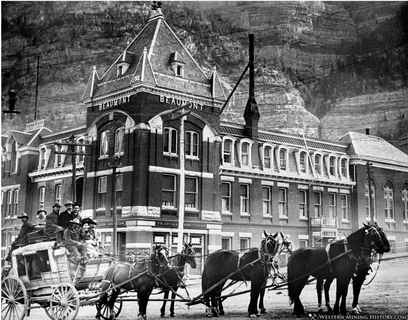Introduction
Ouray County is a time machine to the Old West. It has stunning views of the San Juan Mountains and a rich mining history. Every mountain and trail has a story. It’s not just the beauty that makes this place special. It’s the deep connection to its past.
The Ouray County Museum is a treasure trove of history. It preserves artifacts and tales of miners, ranchers, and the Ute people, who called this land home. The museum ensures that these stories are not lost to time. Visitors get a firsthand look at how life unfolded here over the years. It is more than just a collection of items—it is a window into another era.
I still remember my first visit to the museum. As soon as I stepped through the doors of the old St Joseph’s Miners Hospital, I felt I had entered a different world. Most modern museums lack authenticity. Their creaky wooden floors and the faint smell of old paper are rare. One exhibit, a simulated underground mine, took me into a miner’s life. I could almost hear the pickaxes chipping at the rock. I could feel the weight of the long days these workers endured.
This museum isn’t just for history lovers. It’s a must-see for anyone curious about Colorado’s roots. Learn how communities like Ouray thrived despite tough landscapes and harsh winters. The exhibits tell engaging stories that kids will enjoy too.
History of the Museum

The Ouray County Museum has a fascinating history. It is rooted in the old St. Joseph’s Miners Hospital. This historic building, finished in 1887, was built in 1886. It once served as a lifeline for miners in the rugged San Juan Mountains. Mining accidents and harsh living conditions were common then. The hospital provided critical care to the community. Today, it stands as a testament to the resilience and resourcefulness of the area’s people.
The museum began to protect and share the rich history of Ouray County. The Ouray County Historical Society (OCHS) was key in making this happen. OCHS was founded by dedicated locals. They aimed to keep alive the stories of miners, ranchers, and early settlers. The St. Joseph’s building became a museum in the mid-20th century, due to their hard work. It had been a hospital.
The museum’s exhibits highlight the strong link to mining and ranching. These two industries shaped life in Ouray County. There are also displays on ranching, which was vital to the area’s development. You can see how ranchers adapted to the tough terrain from branding irons to cattle drive photos.
The museum captures the spirit of the past. In the old hospital wards, I imagined the busy days when injured miners were brought in. Doctors worked to save them. A guide shared stories about the building. He pointed out its original features that have survived for over a century.
One moment that stuck with me was seeing the exhibits on Ouray’s ranching heritage. Those artifacts and photos made the stories feel personal and nostalgic.
The museum’s links to mining and ranching show early Ouray life. Here, history is not just shelved. It lives through stories and well-preserved artifacts.
Visitor Experience
Museum Layout
The Ouray County Museum is a maze of history. It has 27 rooms and 40 diverse exhibits. Each room offers a unique glimpse into the past. You’ll find mining tools, ranching memorabilia, and a reconstructed 1800s hospital ward. Walking through the museum feels like peeling back the layers of time, one room at a time.
A highlight of the museum is its interactive displays and virtual tours. They are perfect for visitors seeking a hands-on experience. These modern touches make history accessible to all, even non-museum-goers. Guides share in-depth stories behind each exhibit. Detailed signage ensures you miss nothing while exploring on your own.
I remember stepping into a room that showcased the evolution of mining techniques. The tools on display looked so rugged and well-used, as though they had just been pulled from a mine. A guide explained how these tools were used and how mining shaped the town’s economy. Imagining life for miners in the harsh San Juan Mountains was fascinating.
Educational Opportunities
The museum is not just a place to visit. It’s a place to learn. It offers school programs and workshops to spark curiosity in young minds. They cover geology, the history of mining, and the Ute Indians’ cultural heritage.
During a visit, I saw a group of students in a workshop. They were handling real mining artifacts and learning how miners extracted ore. Watching them, I realized the need to teach local history to the next generation. Such programs help young people value their heritage and its impact today.
Events and Membership
The museum hosts annual events and community programs that bring history to life. From historical reenactments to seasonal exhibitions, there is always something happening. In summer, the museum organizes walking tours of Ouray’s historic district. Guides share fascinating tales about the buildings and their former residents.
Joining the museum is a great way to stay engaged. Membership has perks. They include free admission, discounts, and exclusive newsletters. It helps locals and visitors support the mission to preserve the history of Ouray County.
I attended a community event on my first visit. It was a talk by a historian about Ouray’s early settlers. The historic setting made the stories unforgettable. I wanted to support the museum’s efforts to keep them alive.
The Ouray County Museum offers something for everyone. It will impress history buffs, curious travelers, and students. Every room and event shows how Ouray’s past shapes its present.
Why Visit the Ouray County Museum?
The Ouray County Museum offers a unique experience. It blends history, culture, and storytelling in one place. It’s not just about old artifacts. It’s about stepping into the lives of the miners, ranchers, and families who shaped Ouray. They made it the community it is today.
This museum stands out. It captures the essence of Ouray’s rich history. It bridges the gap between mining and ranching, the area’s backbone. This is not your typical history lesson. It’s a chance to walk in the footsteps of pioneers and early settlers.
A key aspect of the museum is its role in preserving local heritage. During my visit, I was captivated by a photo display of families from the late 1800s. Their faces told stories of resilience, hope, and determination. It was a humbling reminder of the sacrifices to build a life in a rugged yet beautiful place.
For history buffs, the museum is a treasure trove of information. There’s always something new to learn. The exhibits are labeled, and the guides are knowledgeable. Families will find plenty to explore, too. Interactive displays engage kids and adults alike. Even casual tourists can appreciate the museum’s charm.
Conclusion
The Ouray County Museum is more than a collection of artifacts. It’s a testament to the spirit and resilience of the people who shaped Ouray County’s identity. Every story in its walls holds history and beauty, from miners in the mountains to ranchers on
This museum is special. It connects the past with the present. It’s not just a place to see history, but to feel it. During my visit, I stood in front of a detailed exhibit about the Ute Indians and their connection to the land. It reminded me how much we owe to those who came before us. We owe them for what they built and for their stories.
The museum visit left me grateful. It protects history and the people who keep it accessible. It reminds me of our deep connection to the past and the lessons in honoring it. The Ouray County Museum is not just a stop on your journey.


